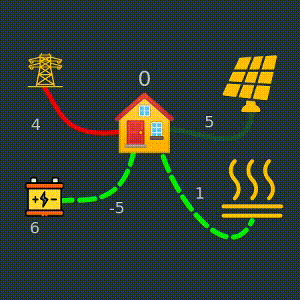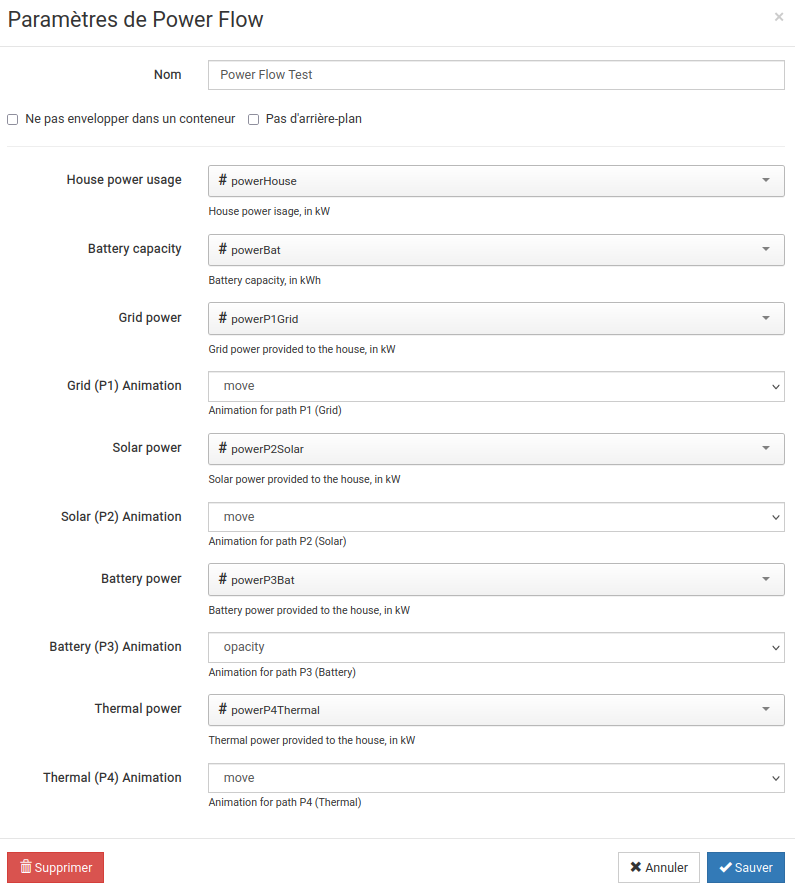habpanel-powerflow-widget
Power flow SVG widget for Habpanel (OpenHAB) Allows displaying values inside an SVG as well as animation based on item states.
Features
The power-flow connects to 6 openhab items:
- 'house' is kW total house power usage (displayed as text)
- 'bat' : battery charge in kwH (displayed as text)
- 'p1' : grid power to the house (displayed as text and animation)
- 'p2' : solar power to the house (displayed as text and animation)
- 'p3' : battery power delivered to (received from) the house (displayed as text and animation)
- 'p4' : thermal power to the house (displayed as text and animation)
The code is easy to change in order to accomodate other SVG and item selections.
History
- 2021-07-29 published!
Parameters
The widget can be configured in habpanel. The basic configuration is the selection of items to display:
- 'house', 'bat' : value displayed as text
- 'p1, to 'p4' : values displayed as text and as animation
The animation for the 4 path can also be selected here ('move', 'pulse', 'opacity' ).
Screenshot
Settings
(sorry for the mixture of languages)
In french, but you get the idea...
Demo
A standalone demo is provided in powerFlow/index.html
If everything is installed properly, you should find this demo on your openhab url, at /static/powerFlow/index.html.
Installing
This widget relies on static files, which must be installed manually. Simply copy the directory powerFlow into the static html area of openhab.
For openraspbian, just do
cp -r powerFlow /etc/openhab2/html/
If you install the file elsewhere, make sure you adjust the widget power-flow.widget.json file accordingly.
How it works
The widget is angular with a single templateURL, which should provide an svg or html containing an svg.
The svg will be found by its id, and all animations are also found using the ids of the path to animate.
The text is simpler to setup. Inside the svg, any text with the form {{house}} will display automatically the value of the variable 'house', which is associated to an item in the widget settings. Same for 'bat', and 'p1' to 'p4'.
Animation
Since the whole svg is accessible to be modified dynamically according to items states, different animations are possible.
This widget focus on path animation of three types: width, opacity or dash offset, which are available in settings as 'pulse', 'opacity' and 'move'. They can be changed in the widget settings, for convenience.
how to customize
Ideally, use inkscape to edit the svg. The Object window and XML window (control-shift-X) are very useful for this.
- make sure the svg has id='svg8' (or change 'svg8' inside power-flow.js, near line 97)
- identify the path with id='pathP1' to 'pathP4' (or change power-flow.js, near line 111)
The svg file name is set as templateURL in power-flow.js, near line 88.
Everything related to OpenHab is in the file control-oh.js. Go there to add/remove tracked items, according to what you need. Note that items names are never hardcoded, but are obtained through the config settings, for convenience.
Have fun!
I hope this is a good example of a dynamic SVG widget that is not too hard to customize, given that the svg is built as a separate file.

